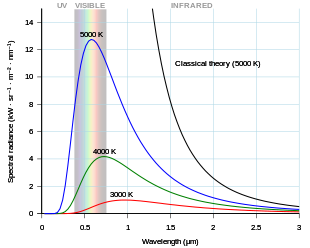

A black body or blackbody is an idealized physical body that absorbs all incident electromagnetic radiation, regardless of frequency or angle of incidence. The radiation emitted by a black body in thermal equilibrium with its environment is called black-body radiation. The name "black body" is given because it absorbs all colors of light. In contrast, a white body is one with a "rough surface that reflects all incident rays completely and uniformly in all directions."[1]
A black body in thermal equilibrium (that is, at a constant temperature) emits electromagnetic black-body radiation. The radiation is emitted according to Planck's law, meaning that it has a spectrum that is determined by the temperature alone (see figure at right), not by the body's shape or composition.
An ideal black body in thermal equilibrium has two main properties:[2]
- It is an ideal emitter: at every frequency, it emits as much or more thermal radiative energy as any other body at the same temperature.
- It is a diffuse emitter: measured per unit area perpendicular to the direction, the energy is radiated isotropically, independent of direction.
Real materials emit energy at a fraction—called the emissivity—of black-body energy levels. By definition, a black body in thermal equilibrium has an emissivity ε = 1. A source with a lower emissivity, independent of frequency, is often referred to as a gray body.[3][4] Constructing black bodies with an emissivity as close to 1 as possible remains a topic of current interest.[5]
In astronomy, the radiation from stars and planets is sometimes characterized in terms of an effective temperature, the temperature of a black body that would emit the same total flux of electromagnetic energy.
- ^ Planck 1914, pp. 9–10
- ^ Cite error: The named reference
Massoudwas invoked but never defined (see the help page). - ^ Cite error: The named reference
emissivitywas invoked but never defined (see the help page). - ^ Cite error: The named reference
gray_bodywas invoked but never defined (see the help page). - ^ Cite error: The named reference
Chunwas invoked but never defined (see the help page).